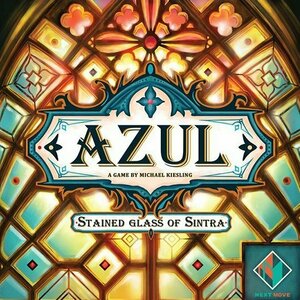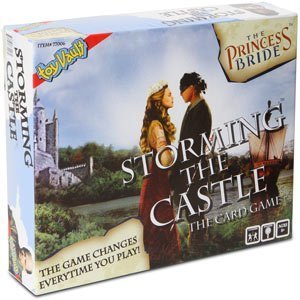
Tiny Epic Quest
Tabletop Game
A world of peace has been torn asunder by the opening of a vile portal from the goblin kingdom....

Tiny Epic Zombies
Tabletop Game
In Tiny Epic Zombies, survivors are always on the run, collecting weapons, killing Zombies and...

Winning Move (Clover Hill Romance #1)
Book
Marek's nerdy charm is an unstoppable force. Gina's anti-dating policy is an immovable object. Or...
Contemporary LGBTQIA+ Romance Small Town Romance Novella
Purple Phoenix Games (2266 KP) rated Azul: Stained Glass of Sintra in Tabletop Games
Oct 15, 2019
For many years you have worked as a tile layer, creating uniquely beautiful mosaics that adorn walls all around the world. Taking your expert skills, you’ve decided to hone your talent into a new form of mosaic decoration – stained glass windows. Select the most colorful glass combinations to create elaborate and beautiful designs, all while being careful not to waste or break any of your supplies in the process! Years of tile-laying have resulted in a steady hand, but glass is a different story. Does your talent and eye for design transcend materials, or are you better left to your familiar ceramic tiles?
Disclaimer: I do not intend to rehash the entire rulebook in this review. I will briefly go over the turn order, but will leave the specifics for you to discover in the rulebook! – L
Like Azul, Azul: Stained Glass of Sintra is a game of pattern building, set collection, and tile placement. To set up, each player receives a palace board, 8 double-sided pattern strips, and glazier (pawn) in their chosen color. All players need to select the same side, A or B, for their palace boards, but the pattern strips can be placed with either side face-up. Place your glazier above the left-most pattern strip, and you are ready to go! The designated score-keeper sets up the score board – placing each players’ scoring cube on the score track and broken glass track, as well as randomly placing 1 tile of each color on the round tracker. Much like OG Azul, a certain number of factories are in play, each populated with 4 pane tiles. Now the game can begin!
On your turn, you may do one of two things – Advance a pattern, or Move your glazier to the left-most pattern strip. If you choose to advance a pattern, you complete these three steps: Select pane pieces of one color from a factory or the middle of the table, place the pieces on one of your pattern strips, and check to see if the pattern is complete. Easy enough! There are a few placement restrictions to keep in mind, and they are detailed in the rulebook. Moving on, after placing your tiles, if the pattern strip is not yet full, your turn is over and play continues with the next player. If you have successfully filled the entire pattern strip, you get to immediately score that window, and then your turn ends. Specific steps for scoring are found in the rulebook. The other action available to you on your turn is to move your glazier back to the left-most pattern strip. Once you do this, your turn is over. Play continues over six rounds, and the player at the end of the game with the most points is the winner!
So how does Azul: Stained Glass of Sintra hold up? I think it’s a pretty great game. It’s very mechanically and thematically similar to the original Azul, but there is enough of a difference in gameplay that keeps it interesting. It doesn’t just feel like the exact same game to me, even if there are many similarities between the two. There definitely is a good amount of strategy involved, and I think the addition of the glazier (which can sorta restrict your placement options) adds a new level of complexity to the game. Do you dare ‘waste’ a turn to reset your glazier, or do you risk the points and try to complete your current pattern strip?
Another great thing about this game is the variability of it. Each player receives 8 double-sided pattern strips to begin the game. The strips can be placed with whichever face up or down that you want. So no two players will ever have the same setup, just as you will probably never have the same setup yourself between plays. One wrong placement could maybe end up costing you the game! There is no ‘right’ setup, and the fact that everyone’s setup will be different makes the game a little more unique.
Of course, the components are great and the tiles are so much fun to handle. Unlike OG Azul, these tiles are semi-transparent and crystalline, giving them the semblance of actual glass. The pattern strips/palace boards are good, sturdy cardboard, and can definitely withstand the amount of manipulation they see each game. My one qualm is with the score tracker. Instead of moving linearly, the score tracker moves kind of zig-zag-y around the board, and it takes me a minute sometimes to read the points and move my marker quickly because my eyes have to figure out the score line. Yeah, it looks cool, but its just a little inconvenient for me while playing.
Overall, I think Azul: Stained Glass of Sintra is a great ‘sequel’ to Azul. It feels familiar in mechanics and theme, but different enough in overall gameplay that I think it is a good stand-alone reimplementation. And guess what? Another Azul game is in the works! Titled Azul: Summer Pavilion, it is yet another game of tile drafting/placement and set collection. Since I have high praise for Stained Glass of Sintra, I am definitely looking forward to this newest version of Azul, coming soon! Purple Phoenix Games gives Azul: Stained Glass of Sintra, a colorful 9 / 12.
Purple Phoenix Games (2266 KP) rated Arctic Scavengers in Tabletop Games
Jun 12, 2019
Welcome to the Ice Age. No, not the animated movie. I’m talking about the real deal. Arctic Scavengers is set in a post-apocalyptic ice age where the cold is deadly and the resources are scarce. Any surviving humans have banded together to form ‘tribes’ that are competing for dominance in this frigid tundra. Can you and your tribe outwit your competitors to become the most powerful group? Or will a bigger and more menacing tribe overpower you and jeopardize your survival?
Disclaimer: The solo variant is only addressed in the Recon Expansion rules. There IS another expansion – HQ – but I have not used that content in my solo plays. This review only encompasses the Base Game and Recon Expansion.
Arctic Scavengers is a deck-building game where players are recruiting mercenaries to their tribes, searching for general resources, and battling other tribes for contested resources. Each turn has two main phases – Resource Gathering and Skirmish. During Resource Gathering, you play cards from your hand to either recruit new mercenaries or search the junkyard for general resources. Any remaining cards in your hand are then used during the Skirmish phase – where the player with the highest ‘fight’ value wins the contested resource for that round. At the end of the game, the player with the biggest tribe wins!
The solo variant has some minor differences, but is played essentially the same way. In a solo game, the contested resource cards are divided into 7 skirmishes to be encountered throughout the game. You can decide when to engage in a skirmish – it is not a requirement to encounter one each turn. After each skirmish, you either win and earn a contested resource, or lose and must permanently discard a card from your losing hand. The game ends when all 7 skirmishes have been encountered. The other difference is that each time you have to re-shuffle your discard pile, you must permanently remove the top card of your new deck from the game. Beyond those changes, the game remains the same. At the end of the game, all cards in your tribe are worth certain numbers of points – the goal is to beat your own personal best score.
In theory, this game sounds super cool! But when I actually got to play it solo, I was seriously underwhelmed. The game feels stagnant in the sense that there is no tension or urgency in your strategy. Since YOU get to decide when to engage in a skirmish, it is possible to just while away the time building up your deck until you have enough cards to beat every skirmish. Yes, you permanently discard a card each time you re-shuffle your discard pile, but if you are able to recruit one or two new cards each turn, it negates the penalty of discarding a card. The ability to choose when to engage in skirmishes is seriously over-powered because there is nothing stopping you from ignoring skirmishes and amassing cards for end-game scoring.
The other grievance I have with the game is regarding the Junkyard – the deck of cards where you ‘search’ for resources. The solo rules do not explicitly address setting up the Junkyard deck at all. So do you use one or not? Not having the Junkyard deck can be a serious hinderance – certain mercenaries cannot be recruited without certain resources. If you DO play with the Junkyard, how many cards do you use? Do you use the corresponding cards from the Base game and BOTH expansions? Only Base game and one expansion? Again, not explicitly addressed. I’ve tried using all of the Junkyard cards and that is difficult – there are just too many cards in that deck. I have gone entire games without coming across a necessary resource just because the size of the deck is too large (and I’m apparently a poor card-shuffler). The simple solution to this ambiguity would have been to just address it in the rulebook. But it’s not there, so I’m left guessing as to how I should set it up every time.
I really like the idea of this game. I really don’t like the solo variant though. Not having forced skirmishes makes the game extremely boring for me – I don’t really need a strategy since I can just recruit cards until I can draw a powerful hand. If there was a timeline for skirmishes – maybe something like “You must encounter one skirmish every other turn” – the game would be vastly different. I would actually need to strategize what cards to recruit and how I should delegate my cards on turns with a skirmish. In most games, I will reach a certain point where I choose to encounter a skirmish (that I know I will lose) just because I am starting to get bored. I appreciate the sentiment of including a solo variant, but this one just does not work.
Arctic Scavengers requires decent strategy and it offers good player interaction in group games. In a solo game, however, it is just imbalanced and boring. This is one solo variant that I would not recommend that you try, unless you are including drastic house rules.
https://purplephoenixgames.wordpress.com/2019/03/06/solo-chronicles-arctic-scavengers/
Connor Sheffield (293 KP) rated You Died, But a Necromancer Revived You in Video Games
Apr 19, 2019
This game is so simple with no other controls to worry about other than your movement using the analog stick, or the D-Pads. The skill to get through the levels however becomes increasingly more difficult, and rapidly more frustrating as you will die.....over and over and over again, only to either respawn at the first level, or if you play on easy mode, you just have to play that same floor again where you just died, but don't bother memorising the traps placements, cos this game doesn't let you off the hook that easily....the maps change even when your playing the same floor you just died on.
Part of you might think at first, I'll wait for the trap to go before I move, but oh no, once again speed and accuracy are key here, you have to time your runs right, get through the traps, try not to get shot, stabbed, squashed, or even more so....try not to run off the edge into a floor full of spikes....it's not as easy to avoid as you might think, one small step in the wrong direction of those floors and you're gone.
This game is addictive, but so utterly frustrating and I had a good laugh on my own the first 100 times I died but I can imagine that with 3 other players on the board in 4-Player Co-Op mode, it will leave you in stitches (hopefully not literally....leave that to your character to injure themselves).
Difficulty levels I have seen this far are simply Easy, or Normal. I don't know if a hard difficulty unlocks after complete the game, because honestly at the minute....I can't complete it. The levels where you face the Necromancer himself are super frustrating and very difficult to do without messing up again and again. However, don't thin easy level makes the traps etc any easier....all it does is simply keep you on the floor you died (unless its a boss battle). The difficulty level of the traps does not change and in Normal mode, if you die, you go right back to the beginning of the level, but luckily there are checkpoints along the way so you don't start from square one again.
Oh and did I mention that as time goes on, the floor eventually starts blowing up behind you, making you rush through to the end.
There are a variety of awesome 8-bit characters to choose from, which gives this whole game a great nostalgic vibe of playing retro games, but with so much added in that it stills feels modern and definitely a game you'll keep going back to. Especially for a game night with friends.
I highly recommend this game for anyone who's a fan of action packed arcade games with a retro feel.
Just try not to throw the remote.
Purple Phoenix Games (2266 KP) rated The Princess Bride: Storming The Castle in Tabletop Games
Jun 12, 2019
So this game, at its heart, is a racing game. You will be racing your pawn toward Humperdinck’s castle in the middle of the table, and you need to traverse several Path cards depicting different areas in the Princess Bride universe. Each of these Path cards will dictate whether you will need specific equipment/items to gain access, or if they are free of that requirement. If you start your turn at the gates of the castle, or have an item allowing you entry sooner, you win!
Ok, the bad. The components are just not great. The box is flimsy and boring. The insert is laughable. The cards are acceptable quality – don’t expect any better quality than normal playing cards picked up at the dollar store. The art on the cards is also very boring and the ink used on the cards seems to be flaking a bit after just a few plays. Screen grabs on cards are fine to me, but the choices made on some of these cards are very questionable. The pawns are poorly designed and they fall over all the time, which is unfortunate when you have to play on a smaller table.
The good now. Owning a Princess Bride game that I can pull out and actually play and have a decent time is a positive for me. There are other games with this same IP that are… not at all fun. This one actually has some gameplay to it that you can enjoy for a while, and even crave future plays. Yes, it feels a bit like Munchkin in that you are trying to achieve the winning goal and your opponents are trying their hardest to delay you. However, it differs due to the fact that the pile-on is slow and you have to basically forfeit your turn to debilitate your opponent. Is that strategy worth it? I’m not so sure…
Does it make you feel like you are in the story? Not really. Do you shudder when the RUSes and Shrieking Eels come into play? Nah, but they are so formidable in the story! Is the GAME worth it though? Yeah, it is. If you are a fan of the book or movie, this is the best Princess Bride game out there. Will another game come out and knock it off the top spot? I hope so. But for now, I am happy with my copy of the game. Perhaps I will look into blinging it out a bit to make it more epic. That said, Purple Phoenix Games gives this one a swashbuckling 7 / 12.
https://purplephoenixgames.wordpress.com/2019/01/21/the-princess-bride-storming-the-castle-review/

Animal sounds kids piano
Education and Entertainment
App
Does your child like music and animals? This kids piano app will provide fun and entertainment for...

Halcyon 6: Starbase Commander
Games
App Watch
*** App Store Game Of The Day *** *** Winner Best PC Game - DIGI Awards 2016 *** *** Runner Up...
games

Game4Cats a Bird Hunting Game for Cats
Games and Entertainment
App
Best Game for Cats on the market! Your cat hunts animated birds on your iPad screen. Each bird plays...



